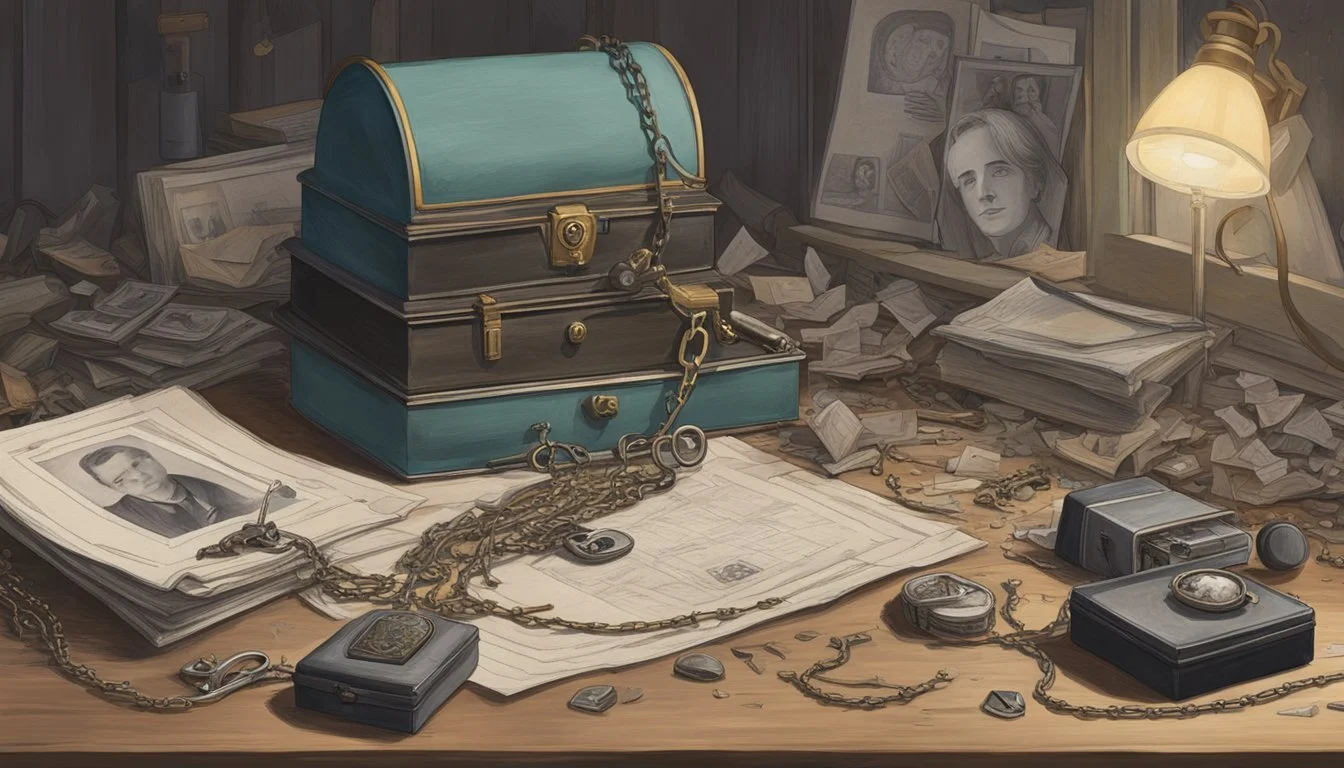Broken Harts: Family Tragedy Podcast Spurs Renewed Interest in Shocking Case
In 2018, a shocking tragedy unfolded when Jennifer and Sarah Hart drove their SUV off a cliff in California, killing themselves and their six adopted children. This devastating event captured public attention and raised numerous questions about the family's history and circumstances leading up to the incident.
The story of the Hart family has since been explored in various media formats, including a podcast and documentary titled "Broken Harts." The documentary delves into the complex issues surrounding the case, examining systemic failures and challenging the public perception of the family's seemingly idyllic life portrayed on social media.
"Broken Harts" provides viewers with a deeper look into the investigation, uncovering dark truths behind the family's online facade. The documentary aims to shed light on the warning signs that were missed and the broader implications of this tragic event on child welfare and adoption systems.
The Harrowing Tale of the Hart Family
The Hart family's story shocked the nation in March 2018. Jen and Sarah Hart, a married couple from Oregon, drove their SUV off a California cliff with their six adopted children inside.
This tragic event marked the end of a complex family history. The Harts had cultivated an image of a happy, loving household on social media. Their posts often featured smiling children and idyllic family moments.
Behind the scenes, however, a darker reality unfolded. Allegations of abuse and neglect surfaced, contradicting the family's carefully crafted public persona.
The children - Markis, Hannah, Abigail, Devonte, Jeremiah, and Sierra - had been adopted from the foster care system. Their ages ranged from 12 to 19 at the time of the incident.
Investigators later determined the crash was intentional. Toxicology reports revealed Jen Hart, the driver, had a high blood alcohol level. Some of the children had been given medication that causes drowsiness.
The case raised serious questions about child welfare oversight and the potential for social media to mask real-life problems. It highlighted gaps in the adoption system and the challenges faced by transracial adoptive families.
"Broken Harts," a podcast and subsequent documentary, delves into this tragic story. It examines the systemic failures that may have contributed to the family's fate and explores the complex issues surrounding the case.
Background and Family Dynamics
Jennifer and Sarah Hart created a seemingly picture-perfect family through adoption. Their story highlights complex issues of race, privilege, and the challenges faced by adoptive families.
Adoption and Family Life
Jennifer and Sarah Hart, a white couple, adopted six Black children from Texas foster care. They first welcomed Markis, Hannah, and Abigail in 2006. Three years later, they adopted Devonte, Jeremiah, and Sierra. The family lived in Minnesota before moving to Washington state.
The Harts carefully curated their public image as a loving, progressive family. They shared photos and stories on social media of their children attending festivals and participating in social justice causes. This portrayal earned them the nickname "Hart Tribe."
Significance of Race and Privilege
The Hart family's dynamics were deeply influenced by race and privilege. As white mothers adopting Black children, Jennifer and Sarah navigated complex social and cultural issues.
Their privileged status allowed them to present a carefully crafted image to the world. This image often focused on their children's participation in progressive causes and events. However, it masked the underlying realities of their family life.
The contrast between the Harts' public persona and private struggles raised questions about transracial adoption, white saviorism, and the intersections of race and privilege in family structures.
The Unfolding of Tragedy
The Hart family's final days were marked by a sudden road trip and a devastating discovery on the California coast. These events shocked the public and raised troubling questions about the family's history.
The Final Road Trip
On March 23, 2018, Jennifer and Sarah Hart left their Washington home with their six adopted children. They drove south through Oregon and into California. Witnesses spotted the family's SUV in Fort Bragg on March 25. Security footage showed Jennifer Hart purchasing groceries alone at a Safeway store.
The family's movements in the days before the crash remain partially unclear. Investigators believe they may have spent time camping or staying in the Fort Bragg area. Cell phone records and witness sightings helped piece together their route along the northern California coast.
The Grim Discovery on Highway 1
On March 26, 2018, a German tourist noticed an overturned SUV at the bottom of a 100-foot cliff along Highway 1 in Mendocino County. Emergency responders arrived to find a horrific scene. The bodies of Jennifer and Sarah Hart were inside the vehicle, along with three of their children.
Over the next weeks, search teams combed the coastline. They recovered the remains of three more children from the surf and beaches. The last body was found on April 7. Toxicology reports revealed Jennifer Hart had a blood alcohol level over the legal limit.
Investigators determined the SUV had been intentionally driven off the cliff. There were no skid marks or signs of braking at the scene. This shocking discovery transformed a tragic accident into a criminal investigation that would captivate the nation.
Investigation and Revelations
The Broken Harts case revealed a disturbing pattern of abuse and neglect hidden behind a carefully crafted public image. Investigators uncovered shocking evidence that contradicted the family's seemingly idyllic life.
Uncovering Layers of Abuse and Neglect
Child Protective Services had received multiple reports of potential abuse in the Hart household. Neighbors reported concerning incidents, including children begging for food. One child showed up at a neighbor's house with missing front teeth, claiming her mothers had withheld food as punishment.
Teachers noted signs of malnourishment and strange behavior from the Hart children. Despite these red flags, the family managed to evade serious scrutiny by frequently moving across state lines.
Evidence and Investigative Findings
Investigators discovered troubling details in the aftermath of the tragedy. The SUV's computer showed the vehicle had stopped at a pull-out before accelerating off the cliff. This suggested a deliberate act rather than an accident.
Toxicology reports revealed Jennifer Hart, the driver, had a blood alcohol content above the legal limit. Five family members, including Sarah Hart, tested positive for significant amounts of Benadryl.
Police reports from previous incidents painted a picture of long-term abuse. One child had told authorities that Jennifer and Sarah Hart withheld food as punishment and hit them with belts.
Media and Documentary Analysis
The Hart family case garnered significant attention across various media platforms. Social media played a crucial role in shaping public perception, while podcasts and documentaries delved deeper into the tragedy.
The Power of Social Media Portrayal
Social media painted an idyllic picture of the Hart family. Jennifer and Sarah Hart carefully curated their online presence, showcasing happy moments and social activism. Photos of smiling children and uplifting captions created a facade of a loving, progressive family. This digital narrative sharply contrasted with the dark reality hidden behind closed doors.
The disconnect between the Harts' online persona and the tragic truth sparked discussions about the deceptive nature of social media. It highlighted how easily people can manipulate their image online, presenting a glamorized version of their lives while concealing serious issues.
From Podcast to Documentary
The Hart family story transitioned from news headlines to in-depth media explorations. Lauren Smiley's investigative reporting laid the groundwork for the "Broken Harts" podcast, produced by Glamour and HowStuffWorks. The podcast examined the case's complexities, interviewing relatives, friends, and experts.
Building on the podcast's success, a documentary titled "Broken Harts" was created for streaming platforms. The film offered visual elements to complement the audio narrative, including exclusive footage and interviews. It explored systemic failures in adoption and child welfare systems that contributed to the tragedy.
The documentary aimed to provide a comprehensive look at the case, balancing the sensational aspects with a thoughtful examination of underlying issues. It served as a cautionary tale about the dangers of accepting social media portrayals at face value.
Public Response and Impact
The Hart family tragedy sparked widespread reactions and discussions. It led to increased scrutiny of adoption processes and child welfare systems, while also prompting community support for the victims.
Community Reactions and Support
News of the Hart family incident shocked local communities and spread rapidly on social media. Neighbors and acquaintances expressed disbelief and sorrow. Vigils were held to honor the children's lives. Support groups formed online to discuss the case and offer resources for those affected by abuse.
Many questioned how the tragedy could have occurred despite prior reports of concern. This led to calls for improved oversight of adoptive families and better communication between child welfare agencies across state lines.
Raising Awareness and Prevention
The case highlighted gaps in child protective services and adoption screening processes. It sparked discussions on recognizing signs of abuse in seemingly picture-perfect families. Child welfare experts used the incident to advocate for policy changes.
Organizations focused on adopted children's rights saw increased interest and support. Educational initiatives were launched to train social workers, teachers, and community members on identifying potential abuse situations. The tragedy also brought attention to the unique challenges faced by transracial adoptive families.
Social media's role in concealing abuse became a key topic. Experts warned about the dangers of curated online personas masking real-life problems.
Reflections on the Case
The Hart family tragedy shook communities across the country. It exposed the dark reality behind a seemingly picture-perfect family.
Many questioned how such abuse could go undetected for so long. The case highlighted potential gaps in adoption and child welfare systems.
Social media played a complex role. The Harts crafted an image of a happy, diverse family online. This facade made it difficult for outsiders to spot warning signs.
The tragedy sparked discussions about:
Racial dynamics in transracial adoptions
Oversight of homeschooling families
Reporting of suspected child abuse
Mental health also emerged as a critical factor. Understanding the parents' psychological state became key to unraveling the case.
The Hart family's story continues to resonate. It serves as a somber reminder that appearances can be deceiving. The tragedy underscores the importance of vigilance in protecting vulnerable children.
Documentaries like "Broken Harts" aim to shed light on these complex issues. They encourage viewers to look beyond surface-level impressions of family life.




